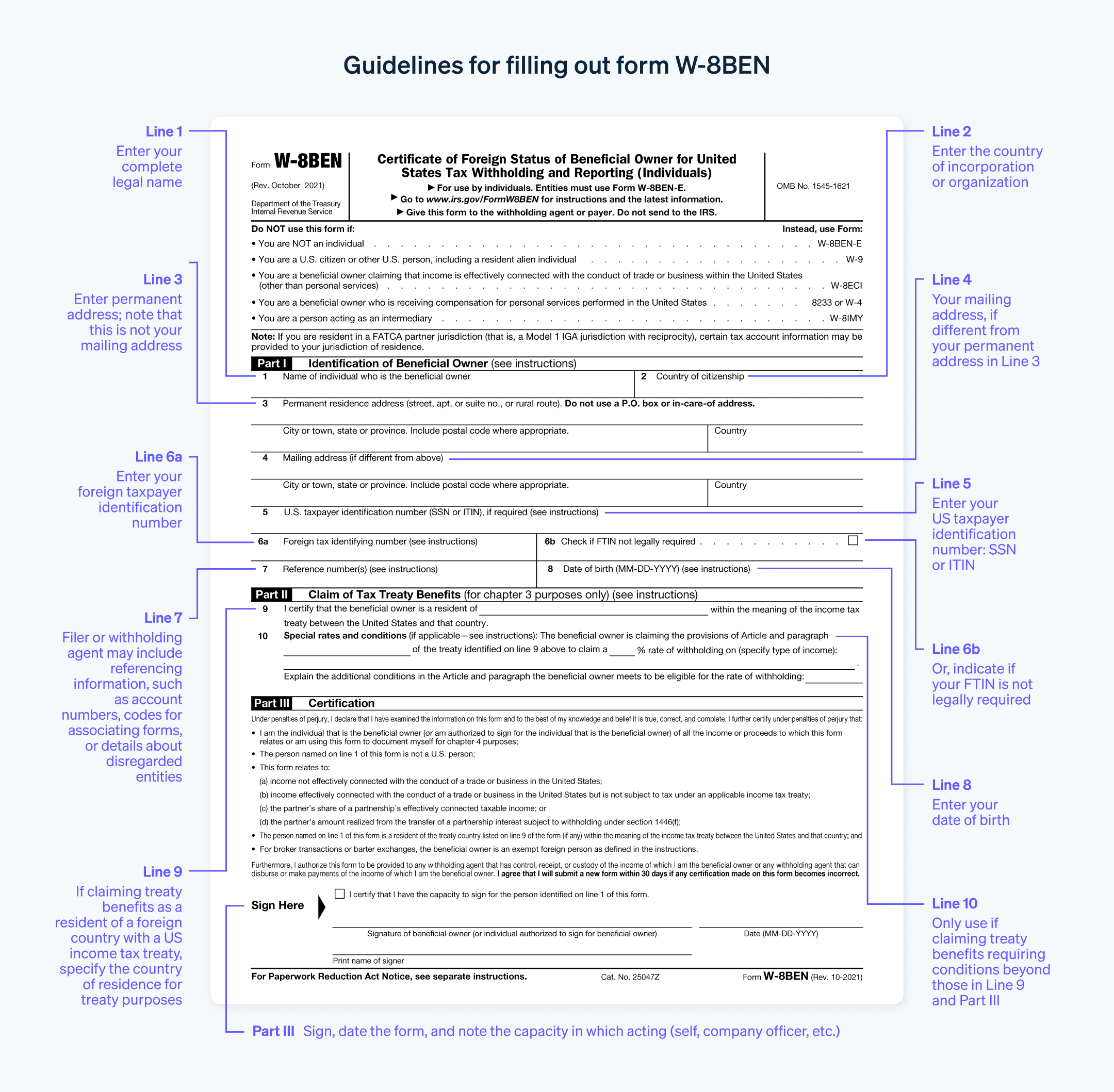对于许多企业,尤其是那些正在跨国扩展业务的企业来说,了解国际税收似乎是一项艰巨的任务。然而,国际税收是影响公司财务健康和声誉的关键因素。在处理美国来源收入和国际税收时,您可能会遇到的一个问题是 W-8 税表。虽然它可能看起来只是国税局的一份文件而已,但该表格对企业非常重要。
无论您是成熟的跨国企业,还是进军新市场的初创企业,了解 W-8 表格都有助于确保您的企业符合美国税务法规。它还可以帮助您利用税收协定优惠,为您节省大笔资金。
下面,我们将详细介绍什么是 W-8 表格、W-8 表格的不同类型、哪些人需要提交 W-8 表格,以及 Stripe 如何帮助企业简化包括 W-8 表格在内的税务表格处理流程。
目录
- 什么是 W-8 表格?
- W-8 表格的类型
- 谁需要提交 W-8 表格?
- 如何提交 W-8 表格
- Stripe 能提供什么帮助
什么是 W-8 表格?
W-8 表格是美国国税局 (IRS) 要求在美国境内有财务交易的外国实体(个人和公司)填写的一份文件。该表格证明了这些实体作为非美国居民的纳税身份,也是管理这些实体的美国来源收入的关键 - 其中包括从美国财产租赁或美国公司分红等来源获得的收入。
该表格还允许这些实体申请获得减免美国预扣款的资格,预扣款从支付给非居民的各类收入中扣除。之所以能做到这一点,是因为美国与许多国家/地区签订了税收协定,旨在防止对海外纳税人双重征税。通过正确填写 W-8 表格,外国实体可证明其非美国身份,并在适用的情况下,受益于本国与美国之间的税收协定。因此,妥善填写 W-8 表格是确保国际税务合规和驾驭错综复杂的美国税务系统的重要因素。
W-8 表格的类型
W-8 表格并不是一份单一的统一文件,而是针对不同情况设计的一系列表格,包括在美国赚取收入的外国个人,以及在美国有财务交易的国际组织或外国政府。请确保根据您的身份选择正确的表格,因为这可能会影响预扣税额,甚至导致免税。
W-8 表格有多种版本,每种版本都有不同的用途:
W-8 BEN 表格是外国个人(例如,在德国为美国公司提供服务的自由职业者)用来确认其非美国身份的文件。这有助于他们利用税收协定的优惠,从而减少他们在美国的纳税义务。此外,他们还可以用该表格来确认自己是所收收入的合法接收人,这一点在涉及股息、版税或利息等收入时尤为重要。
W-8 BEN-E 表格也有类似作用,但针对的是外国实体,而不是个人。例如,一家向美国公司提供软件服务的印度初创科技公司将使用此表格确认其外国身份。此外,如果印度和美国签订了为此类企业提供优惠的税务条约,初创企业可使用此表格申请享受这些优惠。
W-8 IMY 表格适用于中介人,可以是代表他人行事的实体或个人。例如,如果加拿大经纪人为加拿大投资者管理美国证券,该经纪人将使用 W-8 IMY 表格申报其中介身份,并管理这些证券收入的纳税义务。
W-8 EXP 表格由外国政府、国际组织和类似实体使用。例如,从美国投资获得利息收入的外国政府机构将使用此表格确认其地位,并申请美国税法或国际条约规定的美国预扣税款豁免。
W-8 ECI 表格适用于声称其收入与美国贸易或企业直接相关的外国个人或实体。例如,一位在英国工作的营销顾问为一家美国公司的项目提供服务,该项目占顾问收入的很大一部分。使用该表格,顾问可以声称他们的收入与美国企业“有效关联”,这样他们就可以按照与美国个人或实体类似的税率纳税,而不用面对外国实体较高的自动预扣税率。
每种表格都要求申报人提供特定信息,并在美国税收法律和法规中发挥不同的作用。美国国税局网站对每种表格都有更详细的解释,并就何时使用这些表格提供指导。
谁需要提交 W-8 表格?
某些从美国赚取收入的外国个人和企业必须提交 W-8 表格。这些表格有助于美国国税局确定从收入中预扣的适当税额。个人或企业需要提交的 W-8 表格类型取决于其具体情况。
不同的外国实体及其具体情况需要不同的 W-8 表格:
外国个人(W-8 BEN 表格)
从美国来源获得某些类型收入(如利息、股息、租金、特许权使用费和某些其他类型的收入)的非美国个人需要填写 W-8 BEN 表格。该表格用于申请任何适用的税务条约优惠,并核实个人不是美国纳税居民。外国商业实体(W-8 BEN-E 表格)
该表格适用于从美国赚取收入或作为“受益所有人”收款的外国实体。在这种情况下,实际所有人是指从某项目中获得经济利益,但在技术上并非所有者的人员。例如,对银行账户拥有最终控制权的人有可能不在账户所有人之列。但此人是受益所有人。另一个例子是,受益所有人可能是一家从美国公司赚取股息的外国公司。它也可以指在美国开展业务的外国合伙企业。例如,从美国公司赚取股息的澳大利亚软件公司或在美国销售产品的意大利时装设计合伙公司将使用此表格,以便确认其外国身份,并在符合条件的情况下根据美国税收协定申请优惠。外国中介机构或流通实体(W-8 IMY 表格)
此表格适用于外国中介机构、外国合伙企业或外国简单信托或授予人信托。中介可能是美国境外的经纪人或代理人,他们代表客户管理美国投资或收取美国收入 - 例如,香港的经纪公司为客户管理美国证券,或者瑞士的信托公司代表受益人收取美国收入。通过提交此表格,这些中介机构或信托公司可方便地为其客户或受益人代扣代缴税款。外国政府、国际组织或外国中央银行(W-8 EXP 表格)
这些实体提交此表格是为了申请《外国账户税收遵从法案》(FATCA) 的豁免(如果它们适用豁免),并证明其身份,以避免美国税法规定的某些税收。例如,外国中央银行从美国政府债券中获得利息收入。该表格有助于此类实体证明其地位,并根据美国税法或国际税务条约申请美国预扣税豁免。有“实际关联收入”的外国个人(W-8 ECI 表格)
收入与美国贸易或企业有实际关联的外国个人需要填写此表格。“有效关联收入”可包括某些租金和特许权使用费,或从事美国贸易或业务的合伙企业的收入。例如,一名英国演员在一部美国制作的电影中演出,其所获得的收入可被视为与美国贸易或企业有实际关联。通过这种形式,演员可以按照与美国公民相同的分级税率纳税,而不用像外国人那样被统一预扣税款。
当然,美国税法的复杂性以及法律可能发生变化,意味着上述情况可能并未涵盖所有需要 W-8 表格的情形。虽然美国国税局确实为每种表格提供了全面的指南,但仍可能存在未明确涉及的情况。如果您在填写 W-8 BEN 表格时遇到困难,最好向精通美国税收法律和法规的税务专业人士咨询。
如何提交 W-8 表格
提交 W-8 表格涉及几个步骤。由于国税局使用这些表格来确定正确的预扣税额并作为条约福利的证明,因此准确填写这些表格非常重要。以下是如何提交 W-8 表格的指南:
找出正确的表格:如上所述,W-8 表格有几种类型。每种表格都有不同的用途。第一步是确定适合您情况的表格。
下载表格:您可以从美国国税局官方网站下载所需的 W-8 表格。由于美国国税局偶尔会更新这些表格,因此您必须使用最新版本的表格。
填写表格:准确、完整地填写表格。任何错误都可能导致表格处理延误或发生问题。请按照国税局提供的说明填写每份表格。如果您对表格的任何方面不确定,最好向税务专业人士咨询。
提交表格:与许多其他税表不同,W-8 表格通常不直接寄给美国国税局。相反,它们会被交给预扣代理人或付款人,也就是银行、投资公司或您从其处获得收入的其他机构。这些实体使用表格上的信息来决定从您的收入中预扣多少税款,并负责在必要时将表格转交给国税局。
更新表格:W-8 表格的有效期为三年。在此期限之后,必须提交新的表格。如果您的情况发生重大变化,即使三年期尚未结束,您也应填写一份新表格。
这是一份概括性指南,可能未涵盖特定情况下所需的所有细节。在处理税务相关事宜时,请咨询税务顾问或专业人士。

Stripe 能提供什么帮助
Stripe 提供各种工具,旨在精简和简化企业的财务运作。这些工具中包括 Stripe Tax,这是一项旨在为企业自动计算和征收销售税、增值税 (VAT) 和商品及服务税 (GST) 的服务。
Stripe 可以大大减轻企业在 W-8 表格和国际税务合规方面的管理负担。以下是 Stripe 可以提供的帮助:
自动收集 W-8 表格
Stripe 可以帮助从客户和供应商处收集必要的 W-8 表格,减少确保税务合规所需的人工工作量。Stripe 的平台会自动索取必要的表格并对其进行验证,帮助企业履行申报义务并管理与不合规相关的风险。简化税务文件
Stripe 提供简单、用户友好的界面,可集中存储所有必要的税务文件。其中包括国际税务合规所需的 W-8 BEN 或 W-8 BEN-E 等表格。及时提醒
Stripe 还会在 W-8 表格即将过期时(通常每三年一次)发出提醒。该功能可确保企业手头有最新的税务表格,帮助他们避免因表格过期而被罚款。报税支持
Stripe Tax 可以帮助企业更轻松地生成必要的报告,从而为报税做好准备。这些报告可能包括详细说明支付给外国实体的收入的报告,这对于遵守美国国税局有关预扣税收入的报告要求是必要的。
通过简化税务合规流程并为企业履行国际税务义务提供强大支持,Stripe 的工具套件可以成为跨国经营企业的宝贵资产。
本文中的内容仅供一般信息和教育目的,不应被解释为法律或税务建议。Stripe 不保证或担保文章中信息的准确性、完整性、充分性或时效性。您应该寻求在您的司法管辖区获得执业许可的合格律师或会计师的建议,以就您的特定情况提供建议。